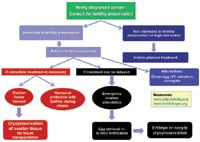Preserving fertility in patients who have cancer
Over the past 25 years, advances in cancer treatment have led to improved long-term survival rates among adult and pediatric cancer patients.

Key Points
Over the past 25 years, advances in cancer treatment have led to improved long-term survival rates among both adult and pediatric cancer patients. The 5-year relative survival rate for childhood cancers is now higher than 75%-and almost 95% for Hodgkin's disease in particular.1 Currently, more than 11 million individuals in the United States are living with cancer, and approximately 450,000 cancer survivors are of reproductive age. Furthermore, 4% to 5% of newly diagnosed cancer patients are younger than 35 years.2 After skin cancer (including both squamous and basal cell carcinoma), breast cancer is the most common cancer among women in the United States.3 Between 5% and 7% of cases of invasive breast cancer-approximately 11,000 cases per year-are diagnosed in women younger than 40 years of age.4 These epidemiologic data underscore the importance of survivorship issues in cancer patients, particularly those of reproductive age.
As the number of long-term cancer survivors increases, fertility has become an important quality-of-life issue among young women with the disease. Unfortunately, the gonads are susceptible to cytotoxic cancer treatment, in particular, to alkylating agents and radiation. Many women diagnosed with cancer at a young age must undergo chemotherapy, which may result in premature ovarian failure and subsequent infertility. Premature ovarian failure after chemotherapy may be associated with the type of chemotherapeutic agents, the cumulative dose of the cytotoxic drugs, and the patient's age, but other factors must be considered as well.5
Although most women of reproductive age wish to preserve fertility, they fail to receive adequate information about fertility preservation. In a Web-based survey of young women diagnosed with breast cancer, Partridge and colleagues demonstrated that only half of all respondents felt that their concerns about fertility had been addressed adequately at the time of diagnosis.6 In 2006, the American Society of Clinical Oncology published guidelines recommending that oncologists discuss fertility issues with patients of childbearing age, and that they refer these women to reproductive specialists and psychosocial service providers, as needed.7 Nevertheless, fewer than half of all US physicians are following those guidelines.8 Failure to discuss fertility may provoke future feelings of grief and regret in patients; therefore, it is important for healthcare professionals to address fertility-related issues, including fertility preservation options, prior to initiating gonadotoxic cancer treatment.

These fertility preservation options are also applicable to patients with other medical conditions that require gonadotoxic chemotherapy and/or radiotherapy, such as systemic lupus erythematosus and microscopic polyangiitis. Furthermore, young patients with sickle cell anemia or other bone marrow pathologies who require hemato-poietic stem cell transplantation should consult with a healthcare professional about fertility preservation prior to treatment.
Until these fertility preservation options are no longer considered controversial, their possible societal implications will remain a subject of debate. As the number of women who delay childbirth because of education and career rises, however, we can predict an increase in the demand for fertility preservation among this population in the future.
